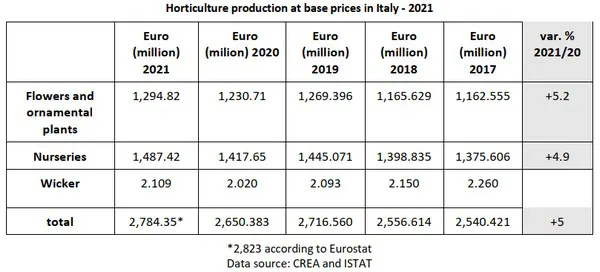Next month, from February 22 to 24, Myplant & Garden will take place again in Milan, Italy. It is one of the most important international fairs in Italy, and the organization recently published the latest official data on horticulture in Italy for 2021.
Tuscany, Liguria, Sicily, Lombardy, Lazio, Puglia, Emilia-Romagna, Veneto, and Piedmont lead the rankings of Italian regions with the highest production value in national horticulture, which in 2021 has grown by 5% from the previous year. The value, which corresponds to 2.8 billion euros (4.6% of base price production in Italian agriculture), is the highest one recorded in recent years.
Production of flowers and potted plants in 2021 has reached almost 1.3 billion euros (+5.1% from 2020), stemming in part (39%) from the regions in the North-West of Italy and in part (35%) from the South and islands.
The production of nurseries, instead, which reached 1.5 billion euros (+4.9%), came mainly from central Italy.

Italian production takes place mainly in four regions: Liguria, which is the leader in outdoor flower production; Tuscany and Lombardy, where the main activities as far as nurseries that produce ornamental plants are concerned to take place; Campania, where companies are specialized mainly in the protected cultivation of flowers.
Tuscany leads nursery production on a national level, with a turnover of 816 million euros (+4% average between 2019 and 2020).
Flower production, instead, is led by Liguria with 386 million euros (+4.6% over the previous two years).

Production of flowers and potted plants did not register any substantial change.

As previously remarked, Tuscany and Liguria lead the overall ranking of Italian flower and nursery production:
- Tuscany (30%)
- Liguria (14%)
- Sicily (9.6%)
- Lombardy (8.9%)
- Lazio (6%)
- Puglia (5.7%)
- Emilia-Romagna (4.8%)
- Veneto (4%)
- Piedmon (2.75%).
Export grows, and the trade balance is doing well
Italian horticulture is considered excellentt on an international level. The export of Italian horticulture products keeps growing. “From our position as leading international business arena for horticulture – comments the leadership at Myplant - we are happy to witness that export, which is pivotal for the development of the industry, has hit a new milestone surpassing one billion euros.”
Italy confirms its role as a net exporter of horticulture products: the production value of export in 2021 has reached 1,143 million euros (903 in 2020). The trade balance stands at 550 million euros (423 in 2020). The European Union is the main export destination for Italian products (about 80% of all exports).
According to Eurostat, the total value of European production in 2021, including flower bulbs and nursery plants, has been 20 billion euros, of which almost 7 billion came from The Netherlands.
70% of Italian export goes to France, The Netherlands, Germany, the United Kingdom, and Switzerland. The Netherlands (75%), Germany, Spain, and Belgium, instead, are the main import countries for
Italy.
“This is a fact that we had advanced in January last year – remarks the leadership - when we noticed that Italian exports of horticulture products had been growing since the first trimester. Moreover,
many companies in the industry had positive feelings about a restart. However, we had also remarked how the regrowth was somehow impeded by the increase in production costs because of the surge in
cost of energy, raw materials for shipping, transport, and fertilizers.”
Troubles and opportunities for forty-thousand hectares of excellence
From the beginning of 2022, after overcoming the hard crisis caused by the pandemic, Italian production has been subjected to pressure again. As already remarked by Myplant, inflation, the
price of energy and political uncertainty on an international level are hitting companies hard, obstructing production, causing prices to increase, impeding the programming of production, and
halting international exchanges.
According to Coldiretti, the first semester in 2022 export has registered an increase of 9% from the first semester in 2021, but import has grown to 60%, potentially compromising the trade balance
for the end of the year.
Moreover, according to Assofloro, the surge in energy costs is unprecedented: almost +100% Summer 2022/Summer 2021 for electricity; +80% Spring 2022 over Spring 2021 for fuel; +1,200%
July 2022 over 2021 for methane.
“All things considered, the exhibiting halls will be packed thanks to the trust and effort of companies that believe in our trade fair as the place to meet, have new business opportunities, and think about the future. We want to think about the future together. Horticulture is an industry that contributes to tackling climate and environmental issues by benefiting the economy, people’s health, and improving the places we inhabit.
We keep witnessing a growing interest and sensibility towards nature: from politics to architecture, from the valorization of outdoor areas to urban regeneration, with climate change as a red thread. We shouldn’t forget the boom of green living in the domestic sphere, micro-cultivations, and people’s awareness of the connection that plants have with our well-being. These are all aspects to which the
horticulture industry contributes.”
For more information
Myplant & Garden
myplantgarden.com
